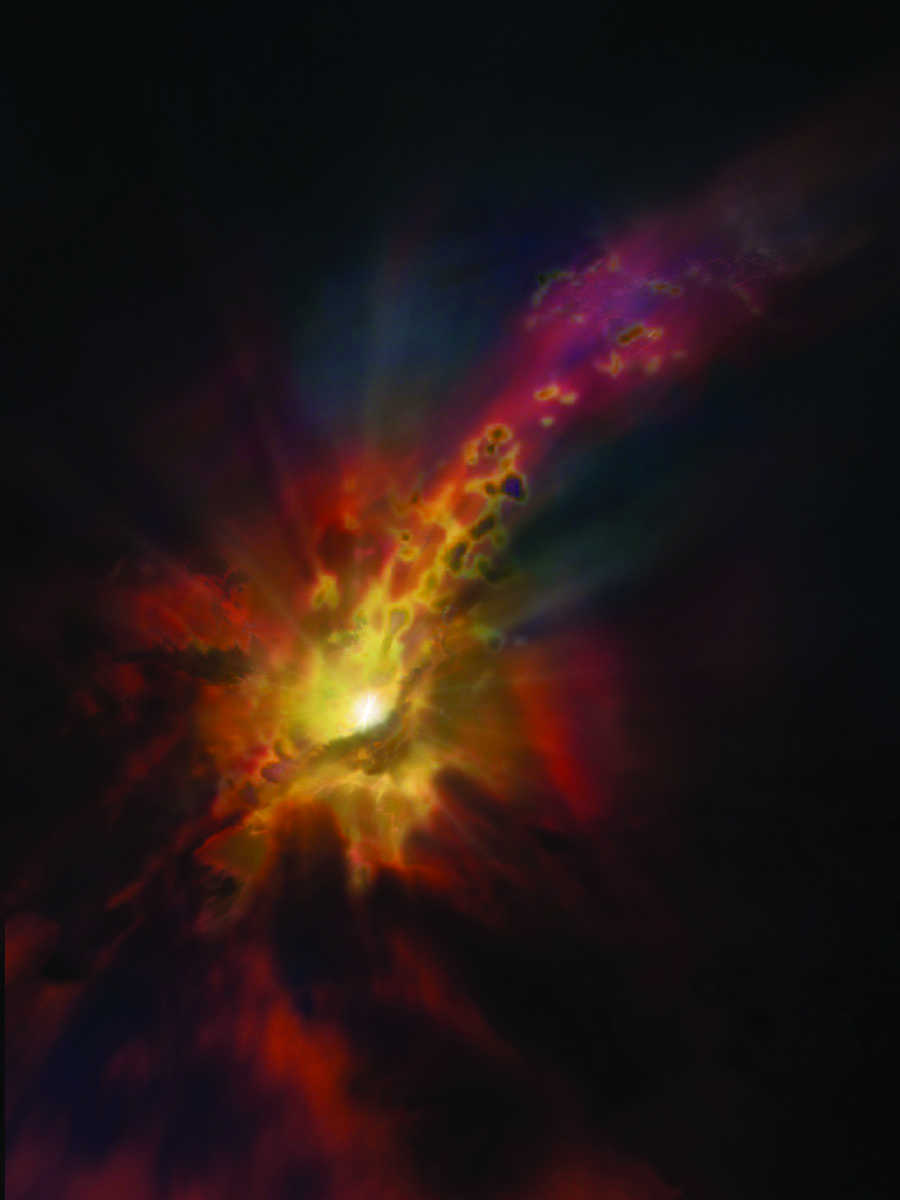Nearly every observed galaxy has a giant black hole at its center. Clues lead us to believe that these monsters, weighing as much a billion suns, consume copious amounts of gas from their environment and occasionally spew-out some of it as powerful jets, bubbles, or heat. How exactly they do this, however, has been a mystery.
“For over half a century, people have simplified supermassive black hole accretion as a smooth spherical inflow of very hot plasma,” said Grant Tremblay, a postdoctoral researcher at Yale. This was not necessarily a bad idea: gas that falls into a gravitational field gets heated up, the stronger the gravity, the higher the temperature. For a dense region like a cluster of galaxies, this temperature is over a hundred million degrees Celsius, ten times the temperature of the Sun’s core. At these temperatures, the gas is mostly ionized, and is called plasma. Since the black hole is at the cluster center, plasma surrounds it on all sides, so it is reasonable to assume that the plasma falls into the black hole from all sides, so warm, spherical accretion sounds like a credible explanation.
But there is another phenomenon to consider, called thermal bremsstrahlung, or “braking radiation.” In hot plasma, electrons zoom freely around until they come close to positively charged ions; then they change trajectories and lose energy. Because of lost energy, hot and dense gases don’t stay hot indefinitely, so no long-term reservoir of warm gas exists to feed a black hole. We can observe the lost energy by measuring the X-ray emissions from galaxy clusters. “The cluster had to lose energy to give us this photon,” said Tremblay. “Every X-ray observation of a galaxy cluster is actually a direct measurement of galaxy cooling.”
In fact, Professor Megan Donahue of Michigan State University, who is a co-author on the paper, explained that the gas near the center of galaxies should actually be cooling rapidly. “The gas near the centers of galaxies is very dense,” she explained. Because the gas is so dense, electrons in the cloud should collide more frequently with positive ions, emitting X-ray radiation and cooling down. The cluster cores should thus be brimming with cold gas, which in turn should form many stars. Instead, astronomers found that the core was mysteriously warm and starless. This discovery motivated theorists to propose a new model, in which central black holes spit energy back into their environment; they named these black holes active galactic nuclei.
So if hot gas doesn’t feed black holes, what does? Donahue says the key is realizing that not all gas is the same, neither uniformly warm nor uniformly cold gas feeds the black hole. Instead, cold clouds precipitate out of the warm gas, and these clouds can then rain down on the black hole. “It’s like this big rain cloud that can produce raindrops that cool very rapidly,” said Donahue. Just as raindrops falling through the Earth’s atmosphere don’t heat up and evaporate, so too can the cold clouds maintain their structure all the way from where they formed to the cluster core. Donahue’s team designed the model by observing galaxy clusters, but could not detect the drops —until now.
In a paper published in Nature this June, the team reported observing the elusive drops from the Atacama Large Millimeter Array (ALMA), a collection of telescopes located in the Atacama Desert. ALMA can accurately measure the position and velocity of celestial objects. The telescope’s resolution is so fine it could see a dime held up in New Haven from where it stands in Chile. Working off of Donahue’s idea that the cold and warm gas lived together, the team tried to observe the cold, star-forming gas in the galaxy cluster Abell 2597.
The supermassive black hole in the center of this galaxy accumulates a lot of matter, but can only do so at a limited rate. The remaining material settles in a large disk around the black hole. Different layers of this rotating disk generate friction as they rub against each other, releasing light and heat. The center of the galaxy cluster should have been bright as a light bulb, but was obscured by a shadow. These shadows were cast by the elusive cold gas clumps, which absorb certain wavelengths of light. “This is one of the first really big pieces of unambiguous evidence for cold molecular clouds that are falling towards a supermassive black hole,” says Tremblay.
The clouds absorbed different wavelengths of light depending on how fast they were moving relative to the black hole. Tremblay was thus able to determine that the clouds were descending towards the black hole at about 67,000 miles an hour. “These things are basically on ballistic trajectories falling towards the black hole,” said Tremblay.
This Nature paper is just the first step towards answering broader questions. How is cold, star-forming gas distributed in galaxies? How is this process shaped by active galactic nuclei? Donahue’s research demonstrated that this gas exists in little clouds, but there’s one last fascinating detail – the clouds themselves are arranged in extended filaments, as long as the cluster itself.
Tremblay thinks pasta is a better analogy for the underlying physics. After the first round of cold gas falls into the black hole, the galactic nucleus releases jets and bubbles of energy. These bubbles, he says, “drag cold gas out of the center of the galaxy, like pulling spaghetti out of hot water.”

